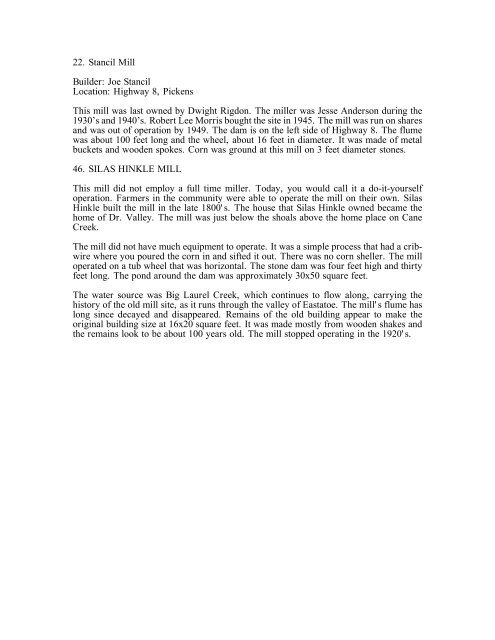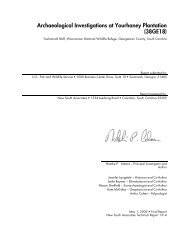Mills in the Upcountry: a Historic Context, and a Summary of a Mill ...
Mills in the Upcountry: a Historic Context, and a Summary of a Mill ...
Mills in the Upcountry: a Historic Context, and a Summary of a Mill ...
Create successful ePaper yourself
Turn your PDF publications into a flip-book with our unique Google optimized e-Paper software.
22. Stancil <strong>Mill</strong><br />
Builder: Joe Stancil<br />
Location: Highway 8, Pickens<br />
This mill was last owned by Dwight Rigdon. The miller was Jesse Anderson dur<strong>in</strong>g <strong>the</strong><br />
1930’s <strong>and</strong> 1940’s. Robert Lee Morris bought <strong>the</strong> site <strong>in</strong> 1945. The mill was run on shares<br />
<strong>and</strong> was out <strong>of</strong> operation by 1949. The dam is on <strong>the</strong> left side <strong>of</strong> Highway 8. The flume<br />
was about 100 feet long <strong>and</strong> <strong>the</strong> wheel, about 16 feet <strong>in</strong> diameter. It was made <strong>of</strong> metal<br />
buckets <strong>and</strong> wooden spokes. Corn was ground at this mill on 3 feet diameter stones.<br />
46. SILAS HINKLE MILL<br />
This mill did not employ a full time miller. Today, you would call it a do-it-yourself<br />
operation. Farmers <strong>in</strong> <strong>the</strong> community were able to operate <strong>the</strong> mill on <strong>the</strong>ir own. Silas<br />
H<strong>in</strong>kle built <strong>the</strong> mill <strong>in</strong> <strong>the</strong> late 1800' s. The house that Silas H<strong>in</strong>kle owned became <strong>the</strong><br />
home <strong>of</strong> Dr. Valley. The mill was just below <strong>the</strong> shoals above <strong>the</strong> home place on Cane<br />
Creek.<br />
The mill did not have much equipment to operate. It was a simple process that had a cribwire<br />
where you poured <strong>the</strong> corn <strong>in</strong> <strong>and</strong> sifted it out. There was no corn sheller. The mill<br />
operated on a tub wheel that was horizontal. The stone dam was four feet high <strong>and</strong> thirty<br />
feet long. The pond around <strong>the</strong> dam was approximately 30x50 square feet.<br />
The water source was Big Laurel Creek, which cont<strong>in</strong>ues to flow along, carry<strong>in</strong>g <strong>the</strong><br />
history <strong>of</strong> <strong>the</strong> old mill site, as it runs through <strong>the</strong> valley <strong>of</strong> Eastatoe. The mill' s flume has<br />
long s<strong>in</strong>ce decayed <strong>and</strong> disappeared. Rema<strong>in</strong>s <strong>of</strong> <strong>the</strong> old build<strong>in</strong>g appear to make <strong>the</strong><br />
orig<strong>in</strong>al build<strong>in</strong>g size at 16x20 square feet. It was made mostly from wooden shakes <strong>and</strong><br />
<strong>the</strong> rema<strong>in</strong>s look to be about 100 years old. The mill stopped operat<strong>in</strong>g <strong>in</strong> <strong>the</strong> 1920' s.







